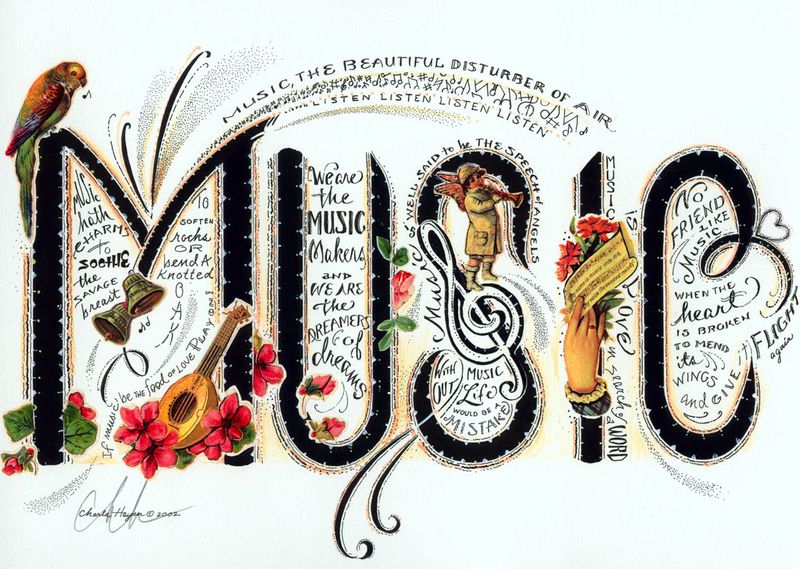Home Frank’s Blog Part 6 – Music and Creativity
Part 6 – Music and Creativity
Frank Fitzpatrick 12/10/2012

|
No time to read? Pick your language & press PLAY
Getting your Trinity Audio player ready...
|
 “Creativity is intelligence having fun.” – Albert Einstein
“Creativity is intelligence having fun.” – Albert Einstein
As part of my morning meditation ritual, I often sing and play music. One of my favorite chants is a mantra to Saraswati – the goddess of music, arts and science. In ancient India, yogis believed that one of the best ways to align our own creative nature with the creative force of the universe was to invoke the spirit of Saraswati. This could be done by singing to her. I was using this practice to help keep me more creative and balanced while working night shoots on a film in Toronto.
One Sunday evening, I was sitting on the floor of my hotel room and watching the autumn sun set behind the multi-colored maples and gothic towers surrounding Trinity College. In the midst of my meditation practice, I took pause and reached for my little red travel guitar. Keeping only the ancient text, I transcribed from voice in my mind an entire new composition – one that I still sing and play in my morning meditations to this day.

I can accept Saraswati as a spiritual metaphor, but I can’t deny the visceral experience, the musical outcome or the science explaining what took place that autumn afternoon. The combined practices of mediation and music had drawn me into such an optimal creative state that the new song could freely rise up from within me. Contrary to what many people believe, however, creativity is neither a magical power nor a talent available to only a limited number of gifted individuals. Creativity is within each of us and the very reason the world exists.

Thousands of books and essays have been written in an attempt to answer the question, “What makes a person creative?” According to Abraham Maslov, we may be asking the wrong question:
“The key question isn’t ‘What fosters creativity?’ But it is why in God’s name isn’t everyone creative? Where was the human potential lost? How was it crippled? I think therefore a good question might be not why do people create, but why do people not create?”
Every child is born with the innate ability to be creative. It is one of the key attributes that sets the human brain apart from the other living beings on the planet. But why do so many individuals feel creatively stifled? Is it because we lack the understanding of what creativity is, or knowledge of how to foster it in children? Or is it because we live in a social framework where, as we become adults, we lose our connection to our creative nature? As adults, we can probably learn a lot more about being creative from kids than we can actually teach them.

Education specialist Sir Ken Robinson says that our current systems of early education are killing creativity. We often punish kids for making mistakes and discourage them from acting or being different. Current education emphasizes imitation, memorization, fixed rules, and pre-established formulas and beliefs about the way the world should work. Children need to learn to follow directions, to know how to replicate what they see and hear, and to be able to participate in coordinated group activities, but those practices do little to encourage creativity. Unfortunately, children restricted to those frameworks alone will have a much more challenging time coming up with new ideas, mastering self-expression or finding innovative solutions to problems on their own. Creativity, which is rarely cultivated in a state of fear, judgment or intimidation, requires a willingness to make mistakes. Beethoven would try as many as 70 different versions of a musical phrase before settling on the right one, and Thomas Edison tried and failed nearly 2,000 times before coming up with a working version of the light bulb.

Of its three basic components: problem solving, self-expression, and imagination, imagination is the wellspring of creativity, for it is our audacity to imagine that pushes the boundaries of possibility.
As Rae Pica says in her article on children, music and creativity, “When children can imagine, they can envision solutions to problems. They can imagine what it’s like to be someone or something else, which helps develop empathy. They can find answers to the question, “What if?” And they can plan full and satisfying futures. For children, creativity is also important because it means there is no one right answer, which provides them opportunities to succeed. This, in turn, fosters feelings of mastery and enhances self-concept.”
Creativity is one of the most essential tools for a child to develop if they want to be successful later in life. Creative development as kids can be directly correlated to their future success in all kinds of careers including scientists, physicians and entrepreneurs.
A recent IBM poll of fifteen hundred CEOs identified creativity as the number one “leadership competency” of the future.

Unfortunately, it looks like Sir Robinson might be right. Creativity scores for school children in America have been on a steady decline since 1990 – right around the time we started removing music and arts programs from our public schools. This is tragic – not just for those students, but also for society as a whole, as we face enormous challenges in the twenty-first century that will require highly creative solutions.
The good news is that we can help turn this around through music, especially by integrating music back into early education. In addition to stimulating creativity, music can help contribute to the development of a more creative mind.
Einstein, considered to be one of the most creative geniuses of the past century, often turned to music to help with his creative process. Einstein told creativity scholar Max Wertheimer that he never came up with new ideas or scientific breakthroughs by thinking in logical symbols or mathematical equations, but in images, feelings and even musical architectures.

Einstein recognized an unexplainable connection between music and his science and often attributed his scientific insight and intuition to music. “If I were not a physicist,” he once said, “I would probably be a musician. I often think in music. I live my daydreams in music. I see my life in terms of music….I get most joy in life out of music”. According to his sister Maja, when faced with a moment of unclarity, Einstein would sit down at the piano and play just a few keys, after which he would get up saying, “There, now I’ve got it”. Something in the music would guide his thoughts in new and creative directions.
Parag Chordia, Director of the Music Intelligence Lab at Georgia Tech, confers that music is a significant, if not essential contributor, to the development and cultivation of creativity. With support from the National Science Foundation (NSF), Chordia is researching the neurological roots of the creative process, and music is a key ingredient. Chordia says, “To be a great engineer; to really produce innovative products and to advance the frontiers of science, you have to be creative. And it’s not just that music is a diversion or an extracurricular, but it’s actually something that’s fundamental to life and mind.” Based on the insights of Einstein and Chorida, it isn’t surprising that the foremost technical designers and engineers in Silicon Valley are almost all practicing musicians.

Playing music – especially improvisation, and creating music – musical composition, are highly engaging processes that activate multiple areas of the brain and help us to develop greater creative capacity. It looks like entering a optimal creative state, however, may be as dependent upon us tempering certain parts of the brain – those responsible for logic, critical thinking, judgment and even self-protection, as it is on activating others. Researchers, like authors Mónica López-González and Charles J. Limb, are using brain imaging to study the neural underpinnings of spontaneous artistic creativity through musical performance, from jazz improvisation to freestyle rap. They’ve found that brain areas deactivated during improvisation are the same as those at rest during dreaming and meditation (other rich states for imagination and creativity), while activated areas include those controlling language and sensorimotor skills.

Simply listening to music can help relax us, and relaxation is key to creativity. Jonah Lehrer, a neuroscientist and author of the bestselling book “Imagine”, says that moments of insight, or creative moments, usually correspond to a steady rhythm of alpha waves emanating from the brain’s right hemisphere. And that is stimulated by relaxation. Why is a relaxed state of mind so important for creative insights?” he writes. “When our minds are at ease – when those alpha waves are rippling through the brain – we’re more likely to direct the spotlight of attention inward… In contrast, when we are diligently focused, our attention tends to be directed outward.”
And Lehrer agrees that one of the oldest and most widely available resources to help the mind relax is music. Music can alter the state of our brainwaves, as well as trigger neurotransmitters, like dopamine, that alter our mood and reward us for creative breakthroughs.

Music can also help stimulate our imagination, one of the key components of the creative process. Listening to a song we love or fully immersing ourselves in a piece of beautiful music can shift our mood, create images in our mind, impact our limbic brain and open us up to new ideas.
Whether your creative spark gets ignited by a beautiful sunset, mantras to Saraswati or your five year old daughter’s smile, there is little doubt in my mind that one of our most inspiring creative muses is music.
View this article on Huffington Post.
I’m here to help YOU create a better world, inside and out.
Contact Me© 2025 Frank Fitzpatrick Website by AllHereIndia












